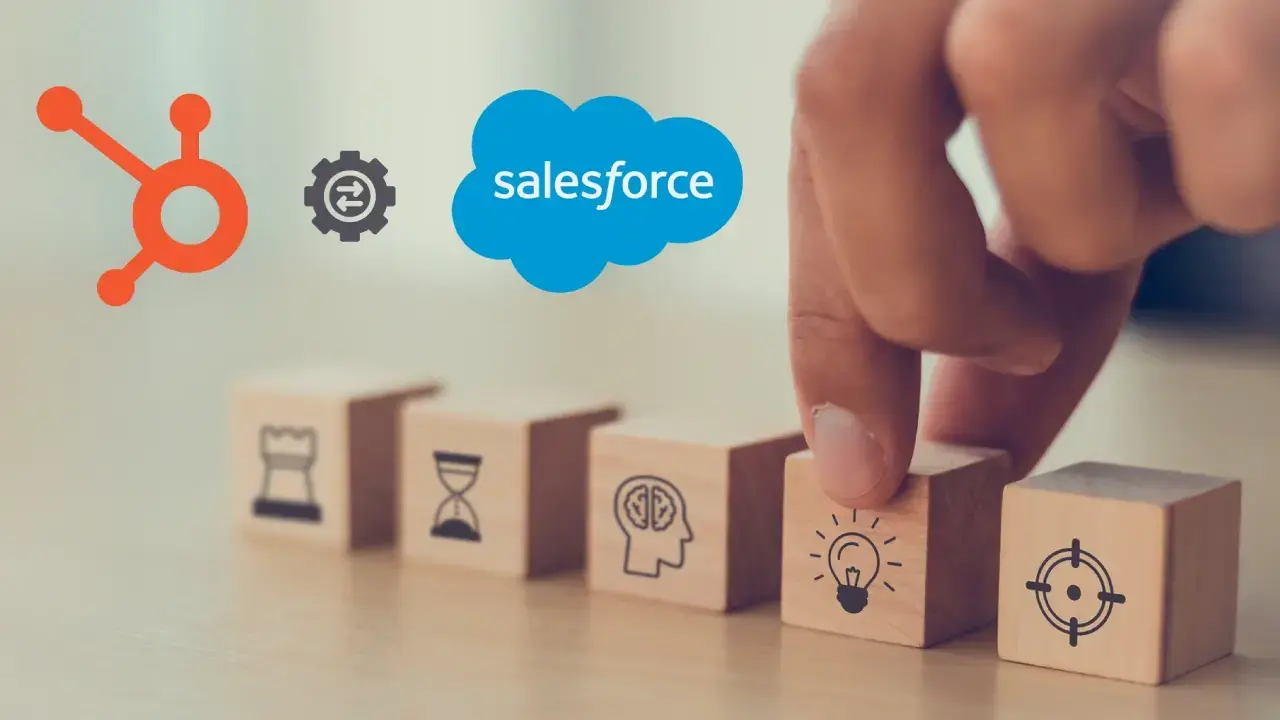
Introduction
You've probably heard the old saying, 'A Stitch in Time Saves Nine,' right? Well, in the world of MarTech tool implementations, it's not just a saying—it's your secret weapon.
Why, you ask?
Think about it. You've invested in this digital transformation, perhaps even over-stretched your budget, to integrate a powerful tool like Salesforce. But what good is it if it sits idle, unused, and not strategically implemented? That's not an asset; it's a liability.
Giphy
If you’ve landed here, you must be scouting for resources to ensure that your Salesforce implementation takes form and delivers results the way YOU envisioned. Whether you’re tech-savvy or not, the aim of this blog is to provide you with the secret formula that worked for us.
So we’ve put years of battle-tested wisdom into a comprehensive Salesforce implementation checklist guide for you. Let’s get started!
Pre-implementation Considerations for Salesforce
If you’re a first-timer at implementing Salesforce, I can already sense the nerves. Without a structured approach, you might encounter compatibility issues, data loss, or worse, security breaches- which can really throw you off track.
Here are some pre-implementation essentials to calm those nerves:
Business Alignment
Begin by aligning Salesforce implementation with your overarching business objectives and conduct a brainstorming session with key stakeholders to identify specific challenges that Salesforce can address.
Solution Selection
Salesforce has the following Cloud offerings:
- Marketing Cloud
- Sales Cloud
- Service Cloud
- Analytics Cloud
- Experience Cloud
- Commerce Cloud
Carefully evaluate your goals and objectives to determine the most suitable Salesforce solutions and consider whether a comprehensive approach involving multiple Salesforce components is necessary for your specific needs.
The Pre-Implementation Checklist
Establish a clear pre-implementation checklist to set up everything you need for the final implementation to go smoothly, including steps for data preparation, staff training, and quality assurance checks.
Customized Timeline
Develop a tailored implementation timeline based on the scale and complexity of your transformation utilizing the SMART framework to set specific timelines for key tasks, including user setup, data refinement, business process mapping, design alignment, pilot testing, deployment, product adoption, and ongoing monitoring.
Cross-Functional Team Formation
Assemble a diverse implementation team with representatives from multiple departments and appoint a capable Project Manager to lead the team and oversee Salesforce adoption within their respective departments.
Progress Monitoring and Metrics
Establish a system for ongoing progress monitoring & define key metrics such as revenue growth, profit margins, case resolution efficiency, and integration timelines to gauge the impact of Salesforce on your organization.
By structuring your pre-implementation considerations in this manner, you can focus better on optimizing and maximizing the long-term benefits of your Salesforce investment.
Here are some top tips for a successful Salesforce implementation offering insights into not only setting it up but also evaluating its effectiveness.
Now that we have covered the basics let’s take a deep dive into the checklist we promised in this blog!
Salesforce Sales Cloud Implementation Checklist
Before you begin the actual implementation phase, there are a few boxes to check to ensure you have a sound Salesforce implementation - wherein, it is properly functioning for all departments concerned, every user adopts the application well, and there is a clear understanding of what Salesforce can do for you.
As we discussed in the blog above, Salesforce has a total of 6 Cloud offerings segmented to achieve different business goals and objectives.
In this blog, we will cover the implementation checklist in detail for the Salesforce Sales Cloud.
Salesforce Editions/ Pricing/Licensing
✅ You can start by determining the scope of your Salesforce utilization. Salesforce Sales Cloud provides six different editions, each with varying functionalities and pricing structures.
✅ These editions range from the fundamental 'Essentials' edition, designed for small companies and startups, to the 'Enterprise' edition, tailored to meet the demands of larger and more intricate businesses. It's essential to select the edition that aligns with your specific business processes and matches your platform licensing and pricing needs.
I suggest utilizing Trailhead to gain a deeper understanding of Salesforce processes and internal operations. Additionally, Salesforceben and Salesforce Help provide extensive resources for exploring Salesforce features, functionalities, and usage.
User Management
To kickstart the Salesforce implementation process, your implementation partner or the individual responsible for Salesforce integration will need the following:
- Role Hierarchy
✅ Your business role hierarchy chart should encompass employees with varying levels of access and responsibilities within the Salesforce Sales Cloud. These roles may encompass senior stakeholders, project managers, system administrators, end-users, and external consultants. Establishing this hierarchy is crucial as it defines who can access records based on their roles, enhancing data security and refining organizational structure.
- Customized User Profiles & Permissions
✅ Following the establishment of the role hierarchy, the next step involves deciding the user profiles & configuring permissions that align with these roles. These profiles will then be assigned specific permissions and access levels, ensuring that each user has precisely the right level of access relevant to their role
Systematizing Data
- Align Data with Long-term Goals
✅ Ensure that your existing data sets align with your organization's long-term objectives.
✅ Identify any gaps or discrepancies between your data and your goals.
- Quality Assessment
✅ Evaluate the quality and accuracy of your data.
✅ Address any errors or integrity issues promptly to maintain data reliability.
- Supplemental Data Analysis
✅ Determine if additional data sets are required to enhance your insights.
✅ Collect and analyze supplementary data to augment your CRM's effectiveness.
- Prioritization
✅ Prioritize essential data sets that align with your core business processes.
✅ Filter out irrelevant or redundant information to streamline data management.
- Data Migration
✅ Ensure a seamless data migration process while preserving comprehensive data integrity by properly exporting all the data from your legacy system into an Excel or CSV so that the implementation partner has a complete record of the data that needs to be migrated.
✅ Safeguard the consistency and reliability of data as you transition to your Salesforce CRM.
Here’s a brief look into the various data migration stages and an approximate timeline for implementation:

scnsoft
Schema Management
Customize standard objects [ pre-built in Salesforce] like Leads, Accounts, Contacts, and Opportunities to align Salesforce with your unique business requirements.
Implement schema management for the following:
✅ Lead Management: Implement lead path and conversion rules to streamline lead data capture and ensure smooth transitions to Accounts, Contacts, and Opportunities.
✅ Account & Contact Management: Customize layouts and fields for Accounts and Contacts to enable the storage of critical business data.
✅ Opportunity Management: Create an opportunity path to help manage sales stages effectively, improving visibility and forecasting.
✅ Product and Pricebook Management: Configure products and price books to enable easy quoting and order management within the organization.
✅ Quote Management: Set up quote templates to ensure accurate and professional quote communication with customers.
Best Practices
✅ Align schema changes with your business objectives.
✅ Regularly review and update custom fields for relevance.
✅ Document schema changes for reference and auditing.
In order to ensure that the schema is set up correctly and aligns properly with your business structure and requirements, here’s a brief understanding of a few ‘objects’:
- Leads: Leads are potential customers or contacts who have shown interest in your products or services but have not yet become official customers. They are typically the starting point in your sales process.
- Accounts: Accounts represent companies, organizations, or entities that you do business with or plan to do business with. They serve as the central point for managing interactions and transactions with these entities.
- Contacts: Contacts are individuals associated with an Account. They can be key decision-makers, employees, or any person with whom your organization interacts within a business context.
- Opportunities: Opportunities represent potential sales deals or projects. They track the progress of potential revenue-generating interactions with Accounts and Contacts. Opportunities are used to manage the sales pipeline.
- Products: Products refer to the goods or services your company offers. They are items that you sell to customers or use in your business operations.
- Price Books: Price Books are catalogs that list the prices of your products or services. They allow you to set and manage different pricing options for your products, which can be used in Quotes and Orders.
- Quotes: Quotes are documents that provide customers with pricing information for your products or services. They are typically used during the sales process to generate quotes for potential customers.
- Orders: Orders represent confirmed purchases made by customers. They serve as records of customer transactions and typically follow the creation of a Quote when a sale is finalized.
You can help your implementation partner understand your internal sales processes based on the objects that you want customized to align the company’s processes with the new Salesforce system.
Lead Management
Configure and set up the standard Lead object to effectively manage leads and optimize lead-related processes.
- Custom Fields Creation
✅ Create custom fields to store business-relevant data for leads.
- Page Layout Management
✅ Manage the page layout for the standard Lead object to ensure it aligns with your business requirements.
- Lead Assignment Rule
✅ Configure a lead assignment rule based on regions, user groups, or other criteria.
✅ Automate the assignment of leads to appropriate users or teams.
- Lead Conversion Rule
✅ Set up lead conversion rules.
✅ Define field mappings for a smooth lead-to-opportunity conversion process.
- Lead Path Configuration
✅ Configure the Lead path to enable users to track the Lead Status conveniently from the highlight panel.
- Activity, Events, and Tasks:
✅ Create Activity, Events, and Task records to capture logs of individual Lead interactions and follow-ups.
- Files or Notes & Attachments:
✅ Implement a system for uploading, referencing, and sharing documents or notes related to individual Lead records.
Best Practices
✅ Setting Assignment rules can help your business achieve better lead and case routing. This way, High-value leads or urgent cases can be assigned with higher priority, ensuring they receive attention sooner.
✅ Often, many Marketing Qualified Leads (MQLs) fail to transition into Sales Qualified Leads (SQLs). By establishing specific conversion rules, you can shift your focus towards higher-quality leads, thereby reducing wasted time on cold or less convertible leads.
✅ Provide training to users on the use of lead-related features.
✅ By default, Salesforce offers the following lead source list which you further add custom fields to
- Advertisement
- Customer event
- Employee referral
- Purchased list
- Trade show
- Webinar
- Website
- other

scnsoft
Account & Contact Management
Configure and set up the standard Account and Contact objects for effective management of customer data.
- Custom Fields Creation:
- Page Layout Management:
- Activity, Events, and Tasks:
- Files or Notes & Attachments:
✅ Implement a system for uploading, referencing, and sharing documents or notes related to individual Account and Contact records.
Best Practices
✅ Collaborate with relevant teams (sales, customer support, etc.) to define custom field requirements.
✅ Consider implementing automation workflows to reduce redundancies and eliminate manual intervention.
✅ Encourage users to maintain accurate records and log interactions for a comprehensive view of customer relationships.
Opportunity Management
Apart from creating custom fields and managing the page layout here’s what you need to check off:
- Activity, Events, and Tasks:
- Files or Notes & Attachments:
- Opportunity Path Configuration:
✅ Configure the Opportunity path and enable users to track the Opportunity Status conveniently from the highlight panel.
Best Practices
There are 9 opportunity stages available in Salesforce which is also customizable:- Prospecting
- Qualification
- Need Analysis
- Value proposition
- Id. Decision Makers
- Perception analysis
- Price quoting
- Negotiation
- Closed (Closed won/ Closed lost)
✅ Strive to strike a balance between having enough stages to reflect your sales process and avoiding excessive complexity. Too many stages can lead to confusion and make reporting challenging. Maintain simplicity where possible.
✅ Ensure accurate logging of activities and events to track the progress of the opportunity stages.
✅ Encourage sales reps to attach relevant documents to Opportunity records for a comprehensive view.
✅ If your company has diverse sales processes based on factors like deal type, product, or service, consider using multiple Record Types and Sales Processes to categorize and manage these variations effectively. This ensures clarity and accuracy in your Opportunity management.
Products and Pricebook Management
Configure and set up the standard Product and Pricebook objects to efficiently manage product offerings and pricing.
- Product Creation
✅ Create products in Salesforce, including relevant details and product families.
✅ Create products immediately upon marking an Opportunity stage as "Closed Won."
- Product Catalog Management
- Price Guide Development
- Pricebook Creation
✅ Create pricebooks to organize and manage pricing for different products and services.
✅ Add the created products to the respective pricebooks.
Best Practices
✅ Create your product catalog list and price books in advance to ensure accurate product information and pricing.
✅ Maintain clear documentation of product families and pricing structures.
Configuration & Setting Up Standard Quote Objects
- Quote Creation
- Quote Template Setup
✅ Set up Quote templates to ensure that Quote designs include the company name and other relevant information visible on the Quote Preview.
- PDF Quote Generation
- Synchronization with Opportunity:
- Attachment to Files and Attachments
✅ Automatically create and attach the Quote document to the Files and Attachments component on the Quote Record when it is sent to the customer.
Best Practices
✅ Collaborate with sales and customer service teams to define Quote template requirements.
✅ Regularly review and update Quote templates to align with branding and messaging.
✅ Train users on the Quote management process, including Quote generation and synchronization.
Salesforce Automation
Automation can be created based on the following criteria:
- Email Sending Automation
- Field Update Automation
- Task Automation
✅ Create automation processes for task generation, ensuring users have checklists of tasks to perform at each stage of a workflow.
Best Practices
✅ Collaborate with relevant teams to identify automation needs and criteria.
✅ Regularly review and refine automation rules to adapt to changing business requirements.
✅ Provide training to users to ensure they are familiar with and effectively use automated processes.
Reports and Dashboards
Create standard reports, charts, and a dashboard to provide an analytical view of the data within the org.
✅ Understand the specific data and metrics that need to be analyzed.
✅ Ensure that the data is accurate and up to date.
✅ Cleanse and validate data as needed for reporting accuracy.
✅ Create up to 6-7 standard reports that address various aspects of the data.
✅ You can also ask your implementation partner to create LWC [lightning web component] to create customized reports based on the reporting preferences.
✅ Design a standard dashboard that consolidates the standard reports and charts.
✅ Arrange components on the dashboard for easy comprehension.
✅ Set up the dashboard to be displayed on the Home Page of the organization
✅ Ensure that users can access analytics conveniently upon login.
✅ Additionally, you can consider integrating the Tableau dashboard into your analytics workflow for conducting higher-level analytics and visualizing complex data. For more information, check out this video:
youtube
By following this comprehensive Salesforce implementation checklist for Sales Cloud, you can successfully optimize your Salesforce deployment to drive growth and improve your lead generation cycle while streamlining your business development operations.
Final Thoughts
As we've explored in this checklist guide, setting clear implementation objectives, choosing the right software, and embracing automation are some of the groundwork key steps for a sound and impactful Salesforce implementation. We’ve given you the foundation, and you can preferably use this as a reference guide when taking assistance from external MOps experts.
You now have all that you need to confidently get started with the implementation, but before you go, here’s something to look forward to, a 2nd Cheatsheet!
We’re looking forward to putting together 2 more valuable checklists to implement the Salesforce Marketing Cloud and Service Cloud respectively. So stay tuned while we churn out these master cheatsheets for an easy- breezy Salesforce implementation!
Oil & Gas company - Improved SFMC Functionality | Streamlined Process
Know how one of the world's largest oil and gas companies achieved an optimized SFMC setup and campaign configuration with RevX.
 Dashboards and analytics
Dashboards and analytics
.webp?width=615&height=80&name=Zignal%20Labs%20Case%20Study%20Banner%20(1).webp)







